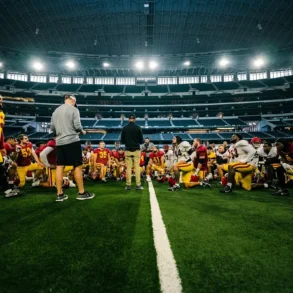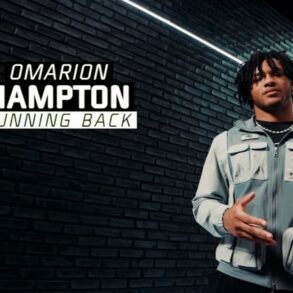
Judge Claudia Wilken of the United States District Court for the Northern District of California issued a key deadline for the House v. NCAA case on Wednesday. Wilken gave the defendants 14 days to come to an agreement over the gradual implementation of roster sizes or risk outright rejection of the landmark settlement.
Wilken wants to see current athletes “grandfathered in” and allowed to remain on rosters until their eligibility expires. This would enable schools to temporarily exceed new roster limits, which include unlimited scholarships. Hard cuts would likely leave nearly 5,000 athletes without spots on rosters across the NCAA’s 43 sponsored sports.
Wilken first epressed concerns over roster limits when she granted the case preliminary approval on April 7. NCAA attorney Rakesh Kilaru opposed the idea, though he agreed to work with the plaintiff’s attorneys on a solution.
“We didn’t come up with these roster limits in an arbitrary way,” Kilaru said after the case’s preliminary approval. “… Roster limits were based on actual people participating in a season, not a particular game.”
Under the settlement, football rosters will shrink to 105 players, resulting in many schools cutting 20 or more players. Some have already begun that process, well before the settlement’s approval.
The $2.8 billion settlement would allow schools to directly pay players millions of dollars starting July 1. Each school’s revenue-sharing formula would be capped at $20.5 million, with the pool increasing 4% each year during the 10-year agreement. The $2.8 billion in back payments for athletes who competed between 2016 and 2024 would also be set in motion upon Wilken’s approval.
What is House v. NCAA?
The class-action anti-trust lawsuit was filed in 2020 by Arizona State swimmer Grant House and women’s college basketball player Sedona Prince seeking an injunction against the NCAA and Power Five conferences. It sought to lift restrictions on revenue sharing of media rights revenues.
Powerful anti-trust attorneys Steve Berman and Jeffrey Kessler represented the plaintiffs.
If approved, the settlement would resolve three antitrust lawsuits: Carter v. NCAA, House v. NCAA and Hubbard v. NCAA.
What’s next?
Revenue-sharing formula: Many schools are preparing to mirror the back-payment formula in their revenue-sharing model for the future. That means roughly 75% of future revenue will be shared with football players, 15% to men’s basketball, 5% to women’s basketball and 5% to all remaining sports. Those numbers will differ from school to school, but most power programs have shared similar models with administrators.
More lawsuits: Concerns over Title IX and antitrust issues will continue after the settlement is approved. However, instead of the NCAA being the lawsuit target, individual schools may soon become the focus. Each school will split the revenue pie based on its own formulas, meaning a women’s basketball player may sue a school if they believe they are not receiving their fair share of cash. The same can be said for a football player if their revenue share is lower than that of a rival player at another school.
The NCAA will (again) turn to Congress: The NCAA has long lobbied Congress to pass legislation protecting the organization and its members from antitrust litigation. Those efforts will heat up once again, starting Tuesday. The House Education and Workforce Committee is scheduled Tuesday to conduct its 13th hearing on college sports.
Conference commissioners, athletics directors and coaches will descend Wednesday on Capitol Hill to lobby Congress for federal legislation that would codify the terms of the House settlement, another campaigning effort that began in earnest in 2019. College leaders may also meet with Sen. Ted Cruz, who is drafting a bill that could offer the NCAA limited antitrust protection.
On Friday, members of the House Judiciary Committee will join NCAA president Charlie Baker for a roundtable discussion in Madison, Wisconsin.
New enforcement model: The power conferences are developing an enforcement arm to oversee the settlement terms. The new organization will police NIL deals between players and third parties, and monitor revenue-sharing practices at schools. This new organization will enforce these new rules and handle penalties against schools and individuals. In effect, the NCAA would cede power to enforce regulations tied to improper benefits to this new organization.
Who is footing the bill? The NCAA is responsible for 40% of the $2.77 billion settlement, and the remaining 60% will come from reducing its revenue distributions to the 32 Division I conferences over the next 10 years ($1.6 billion). The NCAA is utilizing a formula based on revenue distribution presented to each league over a nine-year period starting in 2016, which leans heavily on basketball units tied to NCAA Tournament participation, according to Yahoo Sports. The Power Five conferences – ACC, Big Ten, Big 12, Pac-12 and SEC – will pay 24% of the overall damages, followed by the Group of Five at 10%.The FCS is on the hook for 14% and non-football conferences in Division I will pay 12% of the overall agreement, according to documents reviewed by CBS Sports.
House v. NCAA settlement terms
- $20.5 million salary cap for revenue-sharing at each Division I school (starting July 1)
- $2.77 billion in back payments to as many as 390,000 athletes who played an NCAA sport between 2016 and 2024.
- Outside NIL deals of more than $600 must be vetted by a third-party clearinghouse
- NIL deals must meet “fair market value.” How that fair-market value is determined is the subject of intense debate.
- Unlimited scholarships with new roster size limits
- 88,104 of approximately 390,000 athletes have filed back-pay claims, said plaintiff attorney Steve Berman. That number should reach 118,879 soon, Berman said.
- 343 athletes opted out of the settlement
- 73 athletes object to the terms of the settlement
This post was originally published on this site be sure to check out more of their content.




